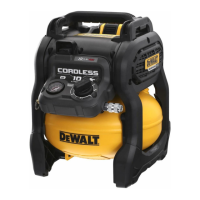11
ENGLISH
WARNING: Risk of Bursting. Water will condense in the
air tank. If not drained, water will corrode and weaken the
air tank causing a risk of air tankrupture.
NOTICE: Risk of Property Damage. Drain water from
air tank may contain oil and rust which can causestains.
1. Set the Auto On/Off switch
1
to "Off".
2. Remove thebattery.
3. Turn the One‑Turn regulator
6
counterclockwise to set the
outlet pressure tozero.
4. Remove the air tool oraccessory.
WARNING: When loosening the hose coupling from the
quick‑connect coupler
9
, the coupling piece of the hose
must be held by hand in order to avoid injuries caused by
the recoilinghose.
5. Place a suitable container under the drain valve to
catchdischarge.
6. Pull ring on safety valve
4
allowing air to bleed from the
tank until tank pressure is approximately 1.4 BAR. Release
safety valvering.
7. Drain water from air tank by opening drain valve
7
on
bottom oftank.
8. After the water has been drained, close the drain valve. The
air compressor can now bestored.
NOTE: If drain valve is blocked, release all air pressure by
connecting a tool to the airline and operating it until tank
pressure is zero BAR and contact the
servicecentre.
Storage
Before you store the air compressor, make sure you do
thefollowing:
1. Review the Maintenance section and perform scheduled
maintenance asnecessary.
2. Always toggle Auto On/Off Switch to "Off" and remove
battery. Drain water from air tank. Refer to To Drain Tank
underMaintenance.
WARNING: Water will condense in the air tank. If not
drained, water will corrode and weaken the air tank
causing a risk of air tankrupture.
3. Store the air compressor in a clean and drylocation.
4. Make sure the air compressor is secured in such a way that it
cannot be started up again by any unauthorizedperson.
5. Frost destroys the pump and accessories as both always
contain water. If there is a risk of danger of frost, store in
frost‑freeconditions.
Cleaning
WARNING: Blow dirt and dust out of the main housing
with dry air as often as dirt is seen collecting in and around
the air vents. Wear approved eye protection and approved
dust mask when performing thisprocedure.
WARNING: Never use solvents or other harsh chemicals
for cleaning the non‑metallic parts of the tool. These
chemicals may weaken the materials used in these parts.
Use a cloth dampened only with water and mild soap.
Never let any liquid get inside the tool; never immerse any
part of the tool into aliquid.
Optional Accessories
WARNING: Since accessories, other than those offered
by
, have not been tested with this product, use
of such accessories with this tool could be hazardous.
To reduce the risk of injury, only
recommended
accessories should be used with thisproduct.
Consult your dealer for further information on the
appropriateaccessories.
Protecting the Environment
Separate collection. Products and batteries marked
with this symbol must not be disposed of with normal
householdwaste.
Products and batteries contain materials that can
be recovered or recycled reducing the demand for raw
materials. Please recycle electrical products and batteries
according to local provisions. Further information is available at
www.2helpU.com.
Rechargeable Battery Pack
This long life battery pack must be recharged when it fails
to produce sufficient power on jobs which were easily done
before. At the end of its technical life, discard it with due care for
our environment:
• Run the battery pack down completely, then remove it from
thetool.
• Li‑Ion cells are recyclable. Take them to your dealer or a
local recycling station. The collected battery packs will be
recycled or disposed ofproperly.
GLOSSARY
Cut-In Pressure: While the motor is off, air tank pressure drops
when accessory is used. When the tank pressure drops to a
certain low level the motor will restart automatically. The low
pressure at which the motor automatically restarts is called
cut-inpressure.
Cut-Out Pressure: When an air compressor is turned on and
begins to run, air pressure in the air tank begins to build. It
builds to a certain high pressure before the motor automatically
shuts off, protecting your air tank from pressure higher than
its capacity. The high pressure at which the motor shuts off is
called cut-outpressure.
Duty Cycle: This air compressor pump is capable of running
continuously. However, to prolong the life of your air
compressor, it is recommended that a 50%–75% average duty
cycle be maintained; that is, the air compressor pump should
not run more than 30–45 minutes in any givenhour.

